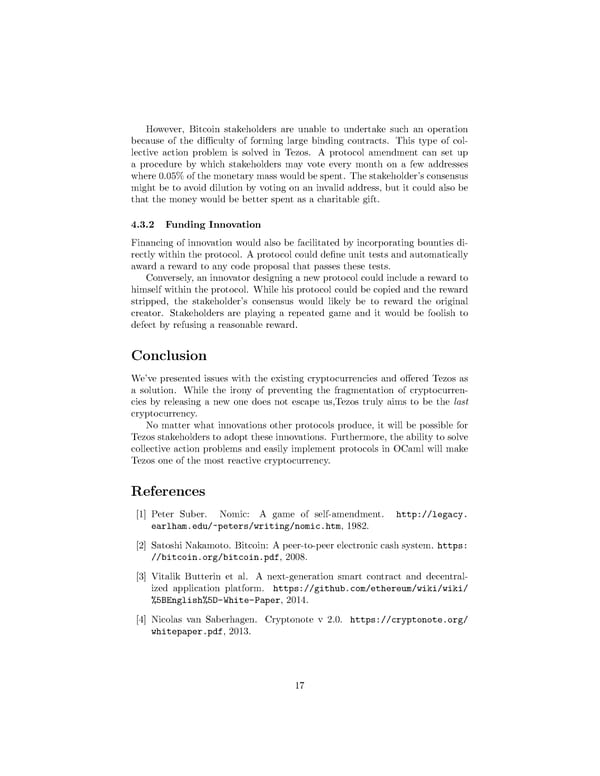However, Bitcoin stakeholders are unable to undertake such an operation because of the difficulty of forming large binding contracts. This type of col- lective action problem is solved in Tezos. A protocol amendment can set up a procedure by which stakeholders may vote every month on a few addresses where 0.05% of the monetary mass would be spent. The stakeholder’s consensus might be to avoid dilution by voting on an invalid address, but it could also be that the money would be better spent as a charitable gift. 4.3.2 Funding Innovation Financing of innovation would also be facilitated by incorporating bounties di- rectly within the protocol. A protocol could define unit tests and automatically award a reward to any code proposal that passes these tests. Conversely, an innovator designing a new protocol could include a reward to himself within the protocol. While his protocol could be copied and the reward stripped, the stakeholder’s consensus would likely be to reward the original creator. Stakeholders are playing a repeated game and it would be foolish to defect by refusing a reasonable reward. Conclusion We’ve presented issues with the existing cryptocurrencies and offered Tezos as a solution. While the irony of preventing the fragmentation of cryptocurren- cies by releasing a new one does not escape us,Tezos truly aims to be the last cryptocurrency. No matter what innovations other protocols produce, it will be possible for Tezos stakeholders to adopt these innovations. Furthermore, the ability to solve collective action problems and easily implement protocols in OCaml will make Tezos one of the most reactive cryptocurrency. References [1] Peter Suber. Nomic: A game of self-amendment. http://legacy. earlham.edu/~peters/writing/nomic.htm, 1982. [2] Satoshi Nakamoto. Bitcoin: A peer-to-peer electronic cash system. https: //bitcoin.org/bitcoin.pdf, 2008. [3] Vitalik Butterin et al. A next-generation smart contract and decentral- ized application platform. https://github.com/ethereum/wiki/wiki/ %5BEnglish%5D-White-Paper, 2014. [4] Nicolas van Saberhagen. Cryptonote v 2.0. https://cryptonote.org/ whitepaper.pdf, 2013. 17
 A Self-Amending Crypto-Ledger Position Paper Page 18 Page 20
A Self-Amending Crypto-Ledger Position Paper Page 18 Page 20